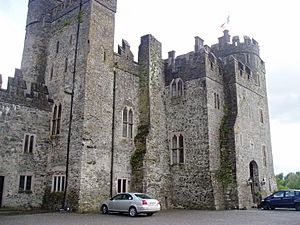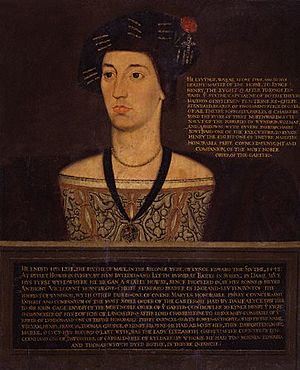Mabel Browne, Countess of Kildare facts for kids
Quick facts for kids Mabel Browne |
|
|---|---|
| Countess of Kildare Baroness of Offaly |
|
| Spouse(s) | Gerald FitzGerald, 11th Earl of Kildare, Baron of Offaly |
| Issue | |
| Lady Elizabeth FitzGerald Lord Gerald FitzGerald, Lord Offaly, Lord Garratt Lord Henry Na Tuagh FitzGerald, 12th Earl of Kildare Lord William FitzGerald, 13th Earl of Kildare Lady Mary FitzGerald |
|
| Father | Sir Anthony Browne KG |
| Mother | Alice Gage |
| Born | c.1536 Sussex, England |
| Died | 25 August 1610 Ireland |
| Occupation | Gentlewoman of the Privy Chamber |
Mabel Browne, Countess of Kildare (born around 1536 – died 25 August 1610) was an important English lady at court. She was married to Gerald FitzGerald, 11th Earl of Kildare, who was also the Baron of Offaly. Mabel came from the Browne family, who were Roman Catholics. Her family held important jobs for the Tudor kings and queens for many years. Mabel herself worked for Queen Mary I and was one of her favorite ladies.
Contents
Mabel Browne's Family
Mabel was born in Sussex, England, around 1536. Her father was Sir Anthony Browne. He was a Knight of the Garter, which is a very special honor. He also held a high position called Master of the Horse. Mabel's mother was Alice Gage.
Mabel's mother passed away in 1540. In 1543, when Mabel was about seven, her father married again. His new wife was Elizabeth FitzGerald. She was an Irish noblewoman famous for her beauty. A famous poem called a sonnet was even written about her.
The Browne family was Roman Catholic. Even when King Henry VIII closed down the monasteries, Mabel's father remained in the king's favor. He was given a large estate called Battle Abbey in East Sussex. Mabel grew up there and at Cowdray House in West Sussex. Her father had received Cowdray House in 1542.
Mabel's father died on 6 May 1548. His wife, Elizabeth, later married Edward Clinton, 1st Earl of Lincoln.
Mabel Browne's Marriage

On 28 May 1554, Mabel married Gerald FitzGerald. She was about eighteen years old at the time. Gerald was the older brother of Mabel's stepmother. He was known as The Wizard Earl because he was interested in alchemy, which was an early form of chemistry.
Mabel and Gerald met at the court of King Edward VI. Some stories say they met at a masked ball. Mabel fell in love with him right away. They were married in the Chapel Royal during the time of Queen Mary I. Queen Mary thought highly of the Browne family.
Mabel was a gentlewoman in Queen Mary's Privy Chamber. This meant she was a close attendant to the Queen. In the same year they married, Gerald helped stop a rebellion led by Sir Thomas Wyatt. After their wedding, Mabel moved to Kilkea Castle in Kildare, Ireland. She spent most of her life there.
Mabel and Gerald had five children together:
- Lady Elizabeth FitzGerald (died 12 January 1617). She married Donnchadh MacConchobhair O'Brien, the 4th Earl of Thomond. They had children.
- Lord Gerald FitzGerald, Lord Offaly (born 28 December 1559 – died June 1580). He married Catherine Knollys. She was a granddaughter of Mary Boleyn. They had a daughter named Lettice. Lettice married Sir Robert Digby.
- Lord Henry Na Tuagh FitzGerald, 12th Earl of Kildare (born 1562 – died 1597). He married Lady Frances Howard and had daughters.
- Lord William FitzGerald, 13th Earl of Kildare (died April 1599).
- Lady Mary FitzGerald (died 1 October 1610). She married Christopher Nugent, the 14th Baron Delvin. They had children.
- Lady Mabel FitzGerald (born 1564 – died 1587). She married Dudley Bagenal and had children.
Mabel Browne's Catholic Faith
Mabel was a favorite of Queen Mary, who was Catholic. However, she was not as welcome at the court of Queen Elizabeth I. Queen Elizabeth was Protestant, and Mabel's strong Catholic beliefs were well known.
Mabel kept several priests in her home. One was her private chaplain, Nicholas Eustace. She also hired Father Compton, who was suspected of being a Catholic priest, to teach her children. Mabel was also a close friend of Jane Dormer, Duchess of Feria. They had become friends while serving Queen Mary. Mabel even provided a safe place and a library for a Jesuit missionary named Robert Rochfort.
Even though Mabel was openly Catholic, she was never accused of treason against Queen Elizabeth. Her husband, however, was suspected of being disloyal in his later years. He spent several years in the Tower of London. But Queen Elizabeth had a soft spot for him. She never took strong action against him. He died in London in 1585, still a free man, but he was not allowed to leave the city.
Mabel Browne's Later Life and Death
Mabel died in Ireland on 25 August 1610. She was about seventy-four years old. Her final years were difficult because of a lawsuit. Her granddaughter, Lettice Digby, claimed that Mabel had unfairly changed her husband's will. Mabel admitted that the will had been changed. However, she said it was done based on legal advice.
In Fiction
Mabel Browne appears as a small character in the historical romance novel Green Darkness by Anya Seton. Her brother, Viscount Montagu, and his wife, Magdalen Dacre, along with Cowdray Castle, are also important parts of the story.


